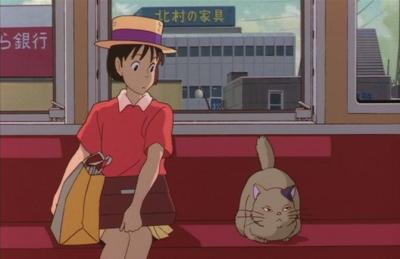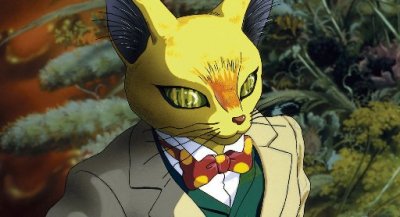Netflix Journal: Whisper of the Heart
 Monday, July 12, 2010 at 2:47PM
Monday, July 12, 2010 at 2:47PM What a strange Ghibli film. Like Ponyo, I grow fonder of this movie the more I reflect on it. The film is entirely focused around the main character Shizuku Tsukishima as she learns something very important about herself; that she wants to be a writer and that hard work is the only way to find out what she's made of. Personally, I love stories about writers. As Shizuku searches for her hidden gems she both lives and creates a wonderful fairy tale of adolescence.

I love stories that show how people or characters make critical choices about themselves and their lives. Whisper of the Heart delivers the transformation of Shizuku so gradually, you'll probably miss the switch if you're expecting something obvious and grandiose. And the more I think about this smooth transformation, the more I realized that such a move is a part of Miyazaki's unique story telling style. Ponyo and Sosuke go on a large scale adventure from a child's perspective and learn to care for each other and their community in the process. Ashitaka and Son learn about the new harmony that must exist between man and nature by living in the divide. Sophie and Howl together learn to love each other, care for themselves, and be responsible for their neo family in the background of all their magical political antics. Chihiro learns to be a confident young girl who fights for her friends while staying true to her heart by working in a magical bathhouse.
As for Shizuku, the slow pace of the film allowed the crafters to show the rich background of Shizuku's life instead of telling the viewer through heavy dialog. The everyday Japanese life is the backdrop for Shizuku's quirky adolescence. Despite her small group of friends, she's known as a bit of a loner who always has her nose in fairy tale books. Escapism is a common theme in Japanese animated stories, and it's represented in multiple ways in the Whisper of the Heart. Shizuku is always reading books and using the fairy tale stories as a means to escape her scholarly studying obligations. She even wishes that her life were more like the fairy tales. The fact that Shizuku desires an escape is only made significant and meaningful when we understand what she's running away from.
From the humble and cramped living conditions to the pressure of getting into a good high school (which is somewhat analogous to getting into a good college for Americans) we experience the life that Shizuku unconsciously wants to escape from. Shizuku's home is not only small but it's filled with a sense of clutter, perseverance, and a lack of personal space. As a wonderful use of visual story telling, we never hear Shizuku or any of her other family member complain about their conditions. With books and papers stacked everywhere, parents who share a single computer to work from home, and a big sister who still shares a room with Shizuku through she has graduated from college can see very clearly how Shizuku's environment shapes her character. All Shizuku knows of growing up, including going to high school, college, and getting a job, she gets first hand from her family. And from her one out burst, we know that Shizuku looks at her sister's lack of career success as a reason why growing up and going through the traditional route may not be anything to look forward to. This is not to mention how much her mother struggles because she went back to school to earn her masters. The house and the home life is temporarily in disarray and it only makes Shizuku unconfident in her future and herself.
Shizuku longs for a better life. Or maybe just a different one. This desire is so strong that she even follows the freelance cat Moon from the train into an unknown neighborhood looking for an "adventure."

The contrast and use of environment is clear and at times breathtaking. From the cramped home, to the school, to traveling around Japan, to the view of the city that almost looks like your in the clouds, and later to the antique/violin shop and Shizuku's imaginary world, the film takes us to what seem like different worlds as opposed to different places in the city. With her nose in the books, her mind away from school, and her head almost quite literally in the clouds, the Whisper of the Heart is a story that sets Shizuku up for a rich transformation exhibited through the various aspects of her life.
Our main character, Shizuku, is ripe for a change. More importantly, we can relate to her story because she's a character flawed in such a common way. After all, who hasn't had to grow up at some point?Who hasn't been unsure of themselves and their future? Shizuku even admits that she was the "dense" one when she finds out that her long time friend has had a crush on her.
The most beautiful part about the film is how realistic or beautifully banal the events are, yet, at the same time there's a double fairy tale in the works. Seiji Amasawa has had eyes for Shizuku for a long time and has apparently done many things to get her attention. But because she was so "dense" and focused on her fairy tale books, she never noticed him even when he would sit right next to her. Seeking adventure, Shizuku tracks down the name of the mysterious Seiji Amasawa by asking the elders at school about the name. After convincing herself that this new boy she's met isn't Seiji, the two grow closer after sharing their hopes, dreams, and feelings of inadequacy with each other. Soon she finds out this boy is actually Seiji and everything changes. So when Seiji goes off to Italy to study violin making, Shizuku digs deep within herself to support him by proving that she has what it takes to be a writer. In the end, both decide to go to high school, grow up a bit more, and envision getting married someday.

Interestingly, while Shizuku's life changed in a fairy tale way, she writes a fairy tale of her own. Taking in many details from her odd life, unique acquaintances, and extraordinary finds (namely the Baron cat statue) a big part of Shizuku's internal state and internal change are expressed through her fictional story. At one point in the film, we can see that Shizuku's quest to prove herself causes her to isolate herself from her family, eat less, ignore school, and work herself to exhaustion. In this way, all of the layers of the story are connected. Creativity like this is why I typically love stories about writers.
Miyazaki's and Studio Ghibili's story telling is so refined, subtle, simple, and powerful it's difficult for anyone else to compete with film.



Reader Comments (2)
Great essay on a great film! You have articulated very convincingly the merits that make Shizuku such a believable character, to me at least. Of all Miyazaki's whimsical and lifelike creations, she is the one that resonated with me; I was able to connect with her grievances and ambitions on so many different levels. I really liked how her sense of independency wasn’t exaggerated or inexplicable; her notion of what it really meant for one to be successful was for one to follow his/her true passion in life, and for Shizuku, that was to be a raconteur of her own imaginations.
One of my favorite scenes in the film is when Shizuku cries after Mr. Nishi has read her manuscripts and critiqued her writings as something that that was good and original but still requires a considerable polish. Her realization that attending high school is the best way to learn more about writing further re-evaluates her self-worth and life goals, in which her shortcomings turn to become an incentive to her, both as an upcoming scholar and as a storyteller.
Make sure to watch “The Cat Returns”. Though It’s not exactly a direct sequel to the “Whisper of the Heart”. It’s technically more like an extension of Shizuku’s creative creation of The Baron. Arguably, the world that Haru gets plunged into is the same world that Shizuku has envisaged in her novel, and one can argue that Haru is experiencing the same events that Shizuku has written in the novel at the time, as she’s now an adult and an accomplished writer. I’ll leave the aspect of narrative derivation of “The Cat Returns” for you to ponder :-)
@ Angelo
Thanks. I'm glad you like my writeup.
I tried to include most of the big ideas that I took away from the film. I only watched it once and tried to collect my thoughts afterwards.
Sounds like you have a pretty good understanding of the film. That scene where Shizuku cries is a great one. I'm partial to the violin-signing-jamboree scene. Seiji said he wasn't a good player, yet his performance was flawless! lol.
Strange as it seems, I actually watched "The Cat Returns" about a year and a half ago. I was a bit confused about the whole thing. The film seemed like a Ghibli dream where bits of other Ghibli ideas and characters float to to create a new story.
Right when I saw the Baron in Wisper of the Heart I knew something was "up." Then when Shizuku decided to write a story about the Baron, many details of The Cat Returns started to come back to me. I know exactly what you mean by the "accomplished writer" theory.
Like I have marked on my "Media I'm Mixing," I have so many things to say about each Ghibli film. Since I've seen Spirited Away, Howl's Moving Castle, and Princess Mononoke the most, I have the most to say about those films. I've been looking for a way to record a podcast or some kind of commentary track so people can watch the movie and listen to my comments at the same time.
Maybe I'll get around to it after I write more about video games, create a few more games, wrap up my senior year in college, and continue writing in the mixed-media blog.
*sigh*